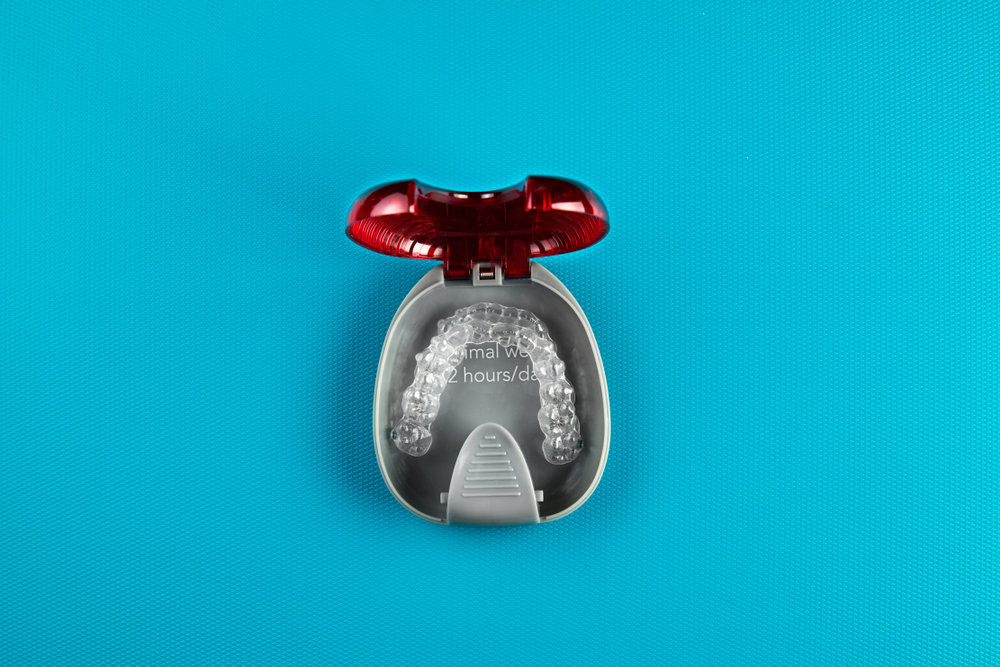
You deserve a straight and healthy smile! So how does cleaning your retainer affect your oral health? Well, a retainer sits on your teeth for a long time — in fact, 8-10 hours when you’re sleeping!
So it’s not surprising that food debris, bacteria, and plaque can accumulate on your retainer. If your retainer plastic looks like it has a milky film, that’s plaque. What’s on your retainer can transfer onto your teeth and lead to tartar — the hardened form of plaque — as well as tooth decay and cavities.
The first step to a clean retainer? Learning how to clean a retainer properly to keep it free of sticky plaque and minimize your replacement time.
How to Clean Retainers
Check out these dos and don’ts for how to clean the Invisalign retainers and Essix retainers we offer at The Brace Place:
Do’s for Cleaning your Retainer
Clean retainers with a soft-bristled toothbrush at least once a day. For extra cleaning power, you can use mild, unscented, liquid dish soap too. Brush your retainer gently to remove plaque, bacteria and food bits and then rinse it off in lukewarm water. We recommend having a separate toothbrush that you use just for retainer cleaning.
Do use cool or lukewarm water to rinse your retainer. You might think that hot water will get rid of bacteria better. However, really hot water can warp your retainer, causing it to lose its custom shape. And if your retainer doesn’t retain its fit, your teeth may not be getting the retention they need.
Do try a paste of water and baking soda. A paste of water and baking soda is a gentle yet effective everyday retainer cleaner. It kills odors, bacteria build-up, and plaque on your retainer without using chemicals. Make a mix of 50/50 water to baking soda — the mixture should be thick enough to stick to your retainer. Brush the paste inside and outside your retainer, then rinse off with cool or warm water.
Make a fresh batch of baking soda/water paste every time you clean your retainer. That way, you minimize bacteria in the paste from the last time you dipped your toothbrush into it.
Do soak your retainer in a solution of water and hydrogen peroxide. Make a 50/50 solution of warm water and 3% hydrogen peroxide. This solution helps take away yellowness in your retainer and kills bacteria, but it doesn’t remove plaque build-up. Ensure the plaque is gone by first brushing your retainer with the baking soda paste above. Soak your retainer in this solution for 30 minutes and rinse well with warm water before putting the retainer into your mouth.
Or soak with water and vinegar. If you don’t have hydrogen peroxide at home, you can use vinegar instead. Make a solution of 50% warm water and 50% white vinegar. Soak your retainer for 20 minutes and rinse well so you don’t taste the vinegar!
Do use a premade retainer cleaner. Yes, you can find many ready-made retainer cleaners at the drugstore if you prefer not to make your own. We at The Brace Place understand that some patients like the convenience of a commercial product and feel more comfortable with it.
So how do you clean retainers with a store-bought cleaner? Most, like Brite retainer cleaner, come in tablets; you simply drop one of these retainer cleaner tablets into water to activate its cleaning power. Submerge your retainer for the amount of time instructed. Retainer cleaner tablets result in clean-looking retainers, minimal to no odor, and no more bacteria.
Not sure which one to use? Dr. Patel and the team at The Brace Place are happy to suggest which retainer cleaner tablets will work best for you.
Do drink lots of water. Water helps wash away food debris and sugars from your teeth and retainer. Food debris and sugars cause bacteria to increase and acids to weaken your tooth enamel. Weakened tooth enamel makes your teeth more susceptible to tooth decay and cavities. So long story short, water keeps oral bacteria at bay. Water also helps prevent dry mouth, which is linked to tooth decay. And a dried-out retainer is more prone to damage and hardened plaque.
Do keep your retainer case clean. Bacteria can thrive in your retainer case just as much as on your retainer. Clean your case with mild dish soap once or twice a week, then wipe with a clean paper towel or cloth. You can also put your retainer case in the top rack of your dishwasher once a week (empty, not with your retainer in it).
Don’ts for Cleaning your Retainer
Don’t clean your retainer with disinfectant wipes. You know, like the kind you’d use to wipe counters and other surfaces. These wipes say they kill most bacteria, but it’s not the same kind as the bacteria on your retainer. Plus, the chemicals in these wipes will harm your teeth and leave an unpleasant taste on your retainer.
Don’t rinse or soak with hot water. As we mentioned earlier, hot or boiling water can warp your retainer. A retainer that has lost its original shape can change the positioning of your teeth, moving them into new misalignment or allowing your teeth to shift back towards their old spots.
Don’t use mouthwash as a retainer cleaner. You might have noticed that the wall of mouthwashes at your local drugstore is quite colorful. As nice as it is to look at, the color in your favorite mouthwash can stain your retainer’s plastic, so don’t soak your retainer with mouthwash.
Don’t brush your retainer with toothpaste. Is this a surprising no-no for how to clean retainers? Perhaps, but we don’t suggest using toothpaste to refresh your retainer because toothpaste can be too abrasive on your retainer, scratching or dulling the plastic.
Don’t store it without a case. It’s worth the extra few seconds to place your retainer in its case. Leaving your retainer out on its own or even wrapped in a tissue or napkin can dry it out, and as we mentioned previously, a dry retainer is more prone to breakage and plaque.
Cleaning Permanent Retainers
At The Brace Place, we not only offer Essix and Invisalign removable retainers but permanent retainers, too. A permanent retainer doesn’t have the same cleaning do’s and don’ts as a removable one since it’s made of a thin wire bonded to the backs of your teeth. To ensure permanent retainers stay clear of plaque and food debris, pay extra special attention to brushing and flossing the backs of your teeth, similar to your diligence with braces.
Caring for your Retainers with The Brace Place
If you have any questions about how to clean retainers or care for your teeth after braces or Invisalign, Dr. Patel and The Brace Place team are happy to help. We can find the right retainer for you and provide retainer cleaning instructions that suit your lifestyle.
Contact us at our Tulsa, or Claremore OK office today!


























